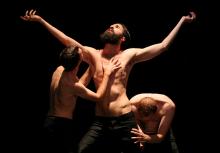Theater Im Ballsaal : Conclusion grandiose for "into the Fields"
The Didier Théron Dance Company resides in Montpellier and is well-established in the French dance world. This company was the consecration of the dance festival “Into the fields” organized by Cocoondance.
Didier Théron decided at short notice to perform his solo “Selfportrait Raskolnikov” instead of the originally planned « Bartleby ». “Selfportrait Raskolnikov” was created in 1997 and inspired by Dostoyevsky’s novel “Crime and Punishment”. Théron himself plays the man who kills a woman in cold blood and subsequently reflects on his act.
On an empty stage he circles a chair, thus creating a space of thought around this center to which he constantly returns. He doesn’t recount the story, but the feverish agitation of the murderer, who searches for rational justifications for his crime, is horrified at himself and slowly sinks into madness.
The literary original is a pretext for Théron, a starting point but also the subterfuge for a complex structure consisting of steps leading nowhere, of crisscrossing lines and searching movements. It is an anti-expressive, precise and intimate 20 minute dance revolving around a character in the process of losing his identity.
Bach’s St. Matthew Passion gradually overlays Daniel Menche’s sound maelstrom, up to the point where the song “I’m singing in the rain” resounds with sheer sarcasm.
Raskolnikov’s existential experience of guilt becomes an absurd proof of divine order.
Following this classic of Théron’s repertory is “Bolero – Men”, the second piece of a trilogy performed to Maurice Ravel’s legendary dance apotheosis, which premiered in 2011. The feminine version was created during the World Expo 2010 in Shanghai.
The masculine version is reduced to three dancers with naked torsos and black trousers, incarnating a forward- pressing power through constant repetition. Small jumps with open or closed legs make up the basic and virtually athletic element of this choreography, which gradually dissolves in the rhythm of musical accumulation.
The physical bodies are like the musical instruments of Ravel’s composition. Through the means of a mechanical and exasperatingly repetitive motive, they are gradually charged with erotic energy. The wiry dancers Lorenzo Dallai and Thomas Régnier, as well as the tall black-bearded Benjamin Dukhan , approach the construction of desire with their athletic energy ; desire also being an uprising in which they fight and support each other.
Practically 20 minutes of mercilessly perfect dance energy performed in squares of light, and inhabited by the refined intelligence of a circular composition.
Elisabeth Einecke - Klövekorn

